MENUMENU
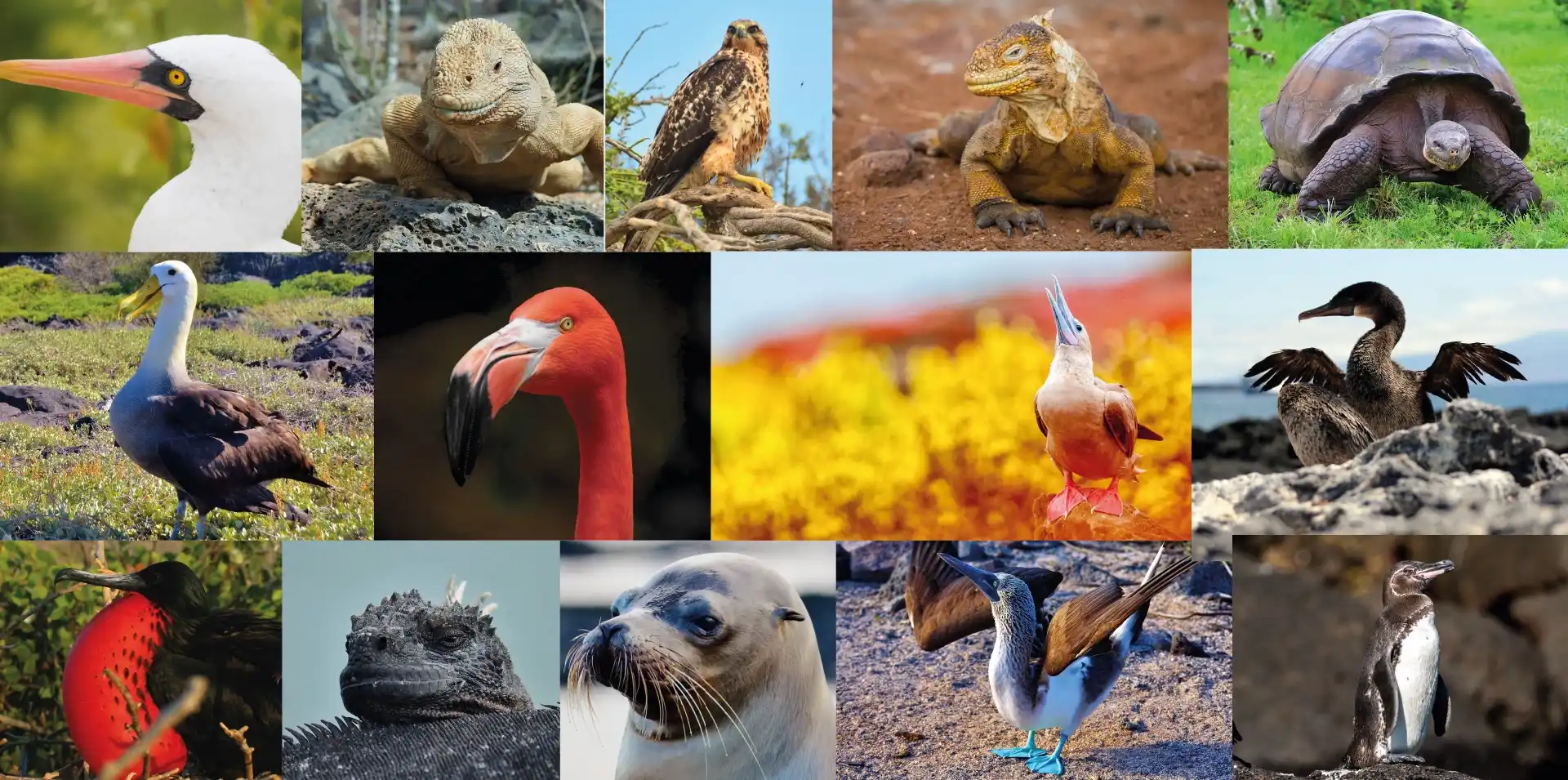
Reading time: 12 mins
The Galapagos Islands are an animal lover’s paradise. That’s why Charles Darwin, the famous naturalist who traveled throughout the world, became enamored by its diversity and beauty. It helped him coin the natural selection theory and be the first to describe many of these species. So, if he was so taken in awe, it’s no surprise that the Galapagos wildlife is incredible for everyone to see.
The archipelago’s many unique endemic species are renowned for casually existing amongst its black volcanic rocks and are always curious to have a human visitor. Given the vastness of the Galapagos archipelago, deciding where to go and what to see can be difficult. The Galapagos Big15 list of iconic species results from a collaboration between scholars, naturalist guides, scientists, and island connoisseurs.
Note: All the photos you’ll see below were taken during Metrojourneys’ expeditions!
Download our Galapagos Basics e-book!
Blue-footed boobies performing their courtship dance in the Galapagos Islands
You can’t help but laugh as these clown-like birds carefully flap their bright blue feet in the air for their mate to see. As they nest on the ground, their entire life cycle, from mating to breeding and caring for their young ones, is on full display.
As their blue feet are a result of the carotenoids in their food supply of fish, their young are born fluffy white with black feet. Their antics make it seem like they can’t fly, but if you look up, you’ll see some soaring above the islands, easily spotted by their tell-tale blue feet.
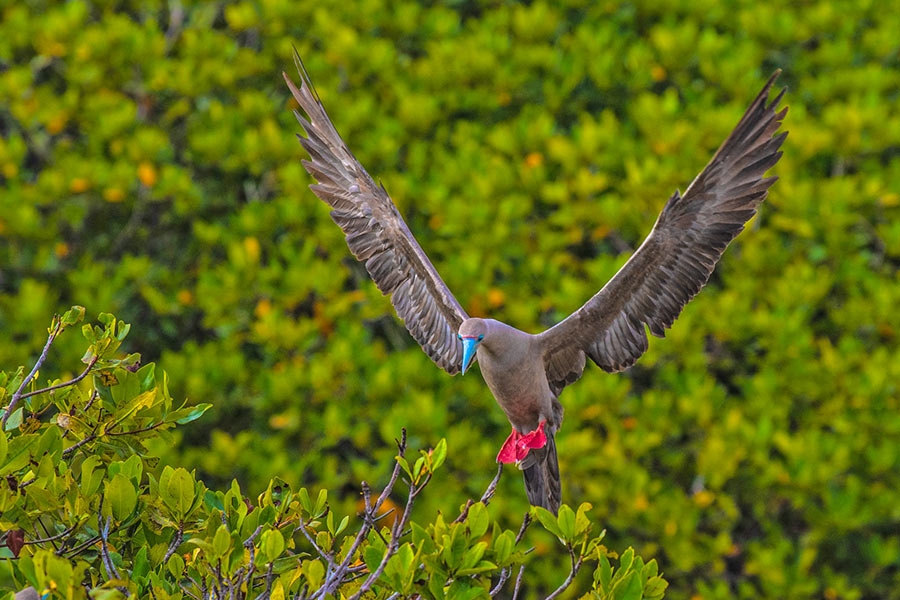
Red-footed booby at Darwin Bay in Genovesa Island
Just like their blue-footed cousins, these quirky seabirds have also opted to attract each other using colored feet. As they are slightly rarer than the other boobies, spotting them is usually an unexpected gift.
They are polymorphic, which means that each individual can look quite different from brown or white plumage. The one thing that can be counted on, though, is their bright red feet. They can be seen in pairs over several mating seasons, and they fawn over one large egg per season. Their singular brood means there’s no squabbling between siblings, nor competing for food.
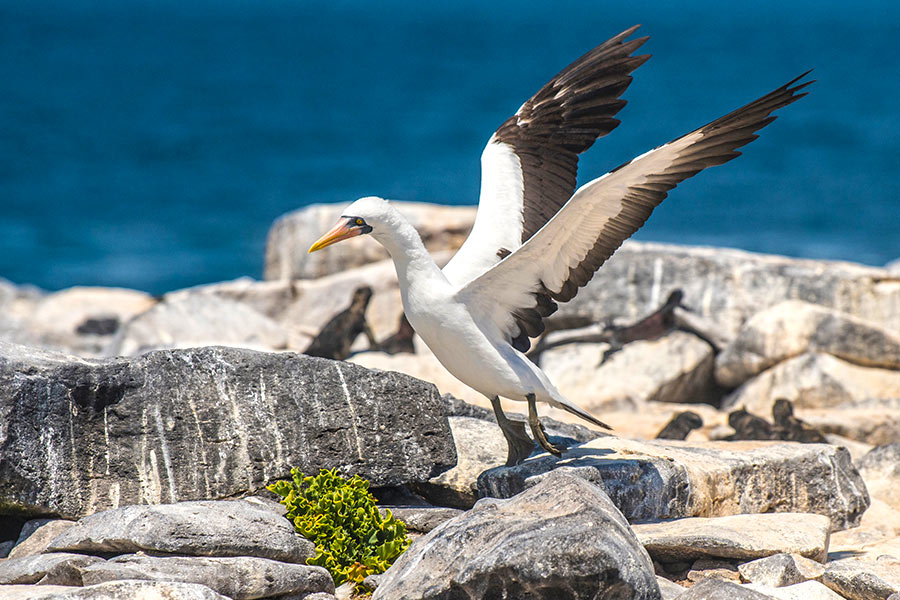
Nazca booby at Punta Suarez in Española Island
Nazca boobies are much bigger than their other booby cousins, reaching up to 35 inches (89 cm) in height. Their markings are very distinctive; they have long orange beaks, a black ring around their eyes and beak, and a slender snow-white body with black underwings and tails. Their natural selection has opted for gray feet, meaning their diet isn’t as specific as those of the more colorful boobies.
Although they don’t appear to have such rigid mating rituals, parents care tirelessly for their young. To keep the egg warm, they use their heavily vascularized feet to transmit heat to the egg.
If you are a birdwatcher at heart, our Mashpi Rainforest and Galapagos Islands Tour Package is everything you’ve ever looked for! This journey will take you from the heart of the Ecuadorian Choco Bioregion (where you can find more than 400 bird species) to the Galapagos, where Santiago Island awaits!
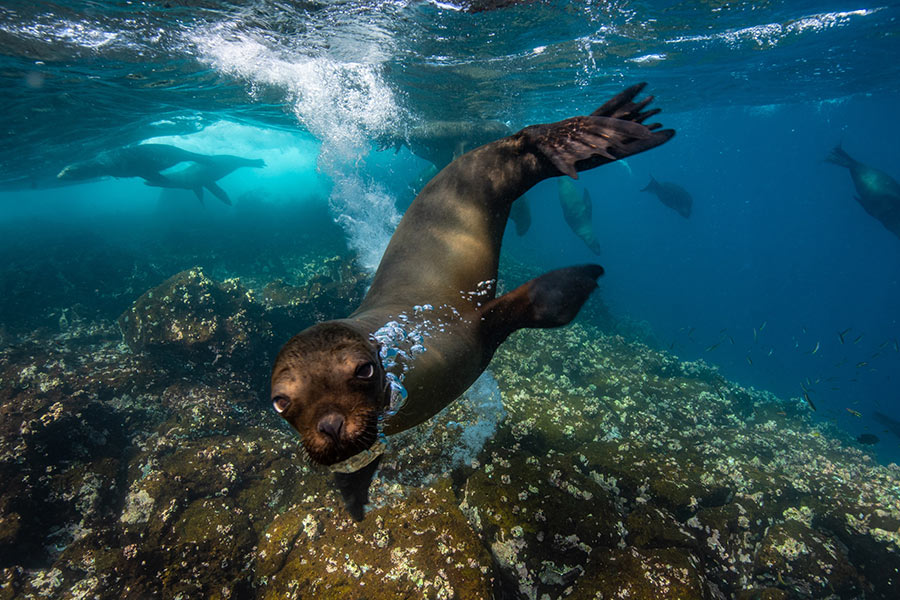
Galapagos Sea Lions swimming by Fernandina Island in Galapagos
These guys are the mischievous teenagers of the islands. They can often be found lolling about all over the islands. The young are known to join humans as they snorkel, trying to encourage a game of fetch. However, be aware that they may have protective mothers nearby.
They are the smallest species of sea lions and distinguish themselves from fur seals by their flatter ear flaps, smoother skin, and pointier noses.
Sleepy Galapagos Fur Seal Pup
In contrast to the Galapagos sea lion, Galapagos fur seals tend to stick to Isabela and Fernandina Islands. Their small bear-like faces peeking out from their thick brown coats can often be seen in the more sheltered areas around these islands.
Galapagos fur seals are the world’s smallest pinniped (seals) and live in colonies. During the mating season, they split into male-guarded territories. In comparison to all other fur seal species, the mother-pup combo tends to stay together for a longer time, giving visitors a better chance to view them together.
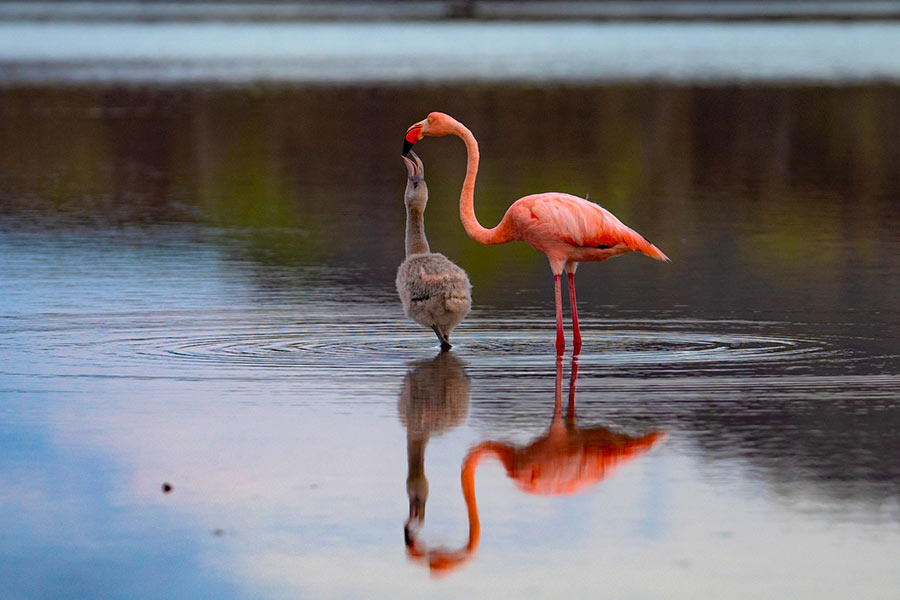
American Flamingo at Santa Cruz Island in the Galapagos
The bright pink plumage of the American flamingo stands in huge contrast to the muddy marshlands where they forage for algae and small invertebrates.
A seemingly enormous bird of contradictions, their graceful marching is awkwardly paired with a goose-like honking. However, their mating rituals are equivalent to those that were commonly seen in ballrooms hundreds of years ago – if a male flamingo walks by and the female is receptive, she follows him!
Male Frigatebird at Genovesa Island in the Galapagos Island
Frigatebirds can be seen flying overhead on most of the islands. The rather bland coloring of the black males and the brown and white females is offset by the adult males’ large bright red gular sac. If you observe them closely during their breeding season, you can see the males resting uncomfortably on the low shrubbery with their beaks pointing toward the sky, making a guttural percussive sound aimed at the females soaring above. Apparently, the bigger and redder the better! If a female approves, she’ll fly down to initiate the romance.
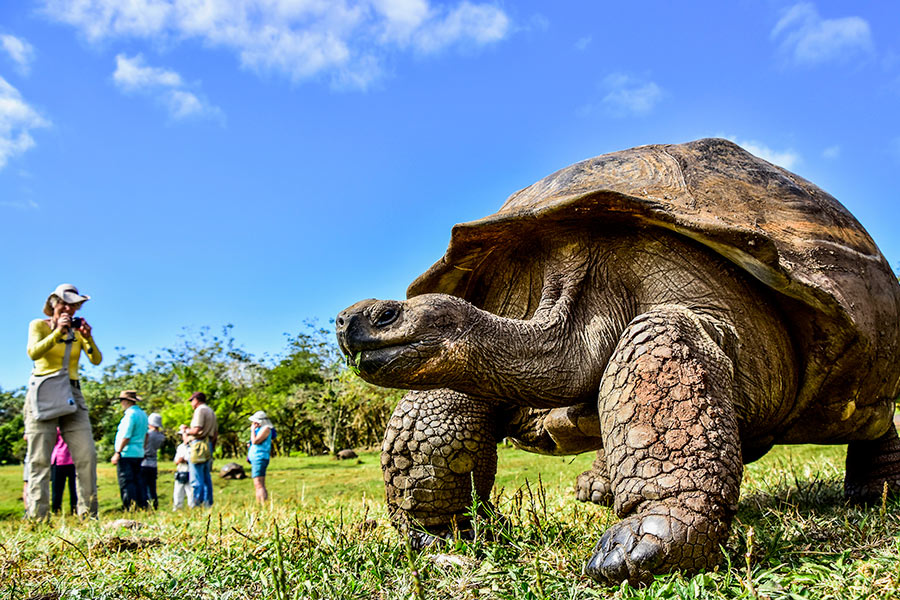
Galapagos Giant Tortoise in Santa Cruz Island
The ancient Galapagos giant tortoises roam the highlands of Santa Cruz and other islands, slowly lumbering from one natural banquet to another. They are reasonably receptive to human interaction but will plead ignorance if frightened and disappear into their shells.
Their lives are just like ours; they enjoy a mud bath, graze on tender shrubbery, and, even though they appear sedentary, they are gradual migrators that can travel up to 3.7 mi (6 km) over 6-week periods to take advantage of the green shrubs in the lowlands during the rainy season. Numerous breeding programs work tirelessly to try to increase and sustain giant tortoise populations.
If you want to see them face to face, embark on our Colombia and Ecuador tours!
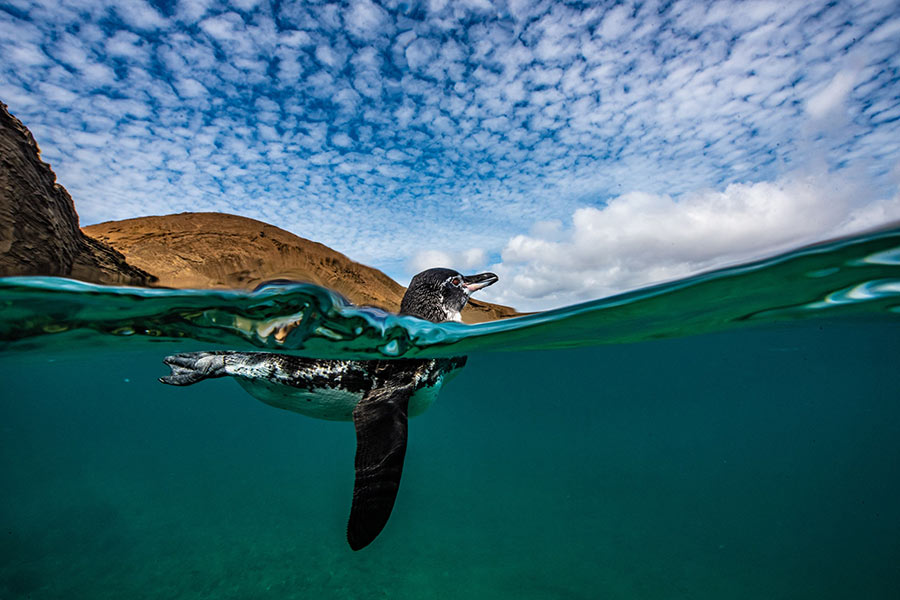
Galapagos Penguin swimming in Bartolome Island
Isn’t it surprising to see a typically cold-climate species chilling on the equator? These guys are the very embodiment of the exception to the rule. Initially attracted to the cooler Humboldt and Cromwell currents and schools of smaller fish, they have adapted remarkably to life in paradise. These tiny black- and white-banded penguins, averaging just 19 inches (49 cm) in height, are often seen in their mated pairs, shading themselves or diving for fish.
In high temperatures, they will hunch forward to keep the sun off their biggest heat exchange surface – their feet. They are often seen panting and tend to hide their eggs in the deep crevices of volcanic rocks.
Galapagos Marine Iguana
Although their terrestrial counterparts are often more recognizable, these black-crested dinosaurian creatures can often be seen sunbathing on the volcanic rocks to raise their body temperature or swimming elegantly through the water in search of algae. They can dive and forage underwater for up to 30-40 minutes.
As their body cannot tolerate the high salt content of their food, they are often seen sneezing and snorting. And that strange white coating over their head? That’s all of the salt that has been sneezed out!
You may notice that some of these iguanas are banded or have light-colored speckles. These are a result of a male marine iguana and female land iguana creating a hybrid iguana.
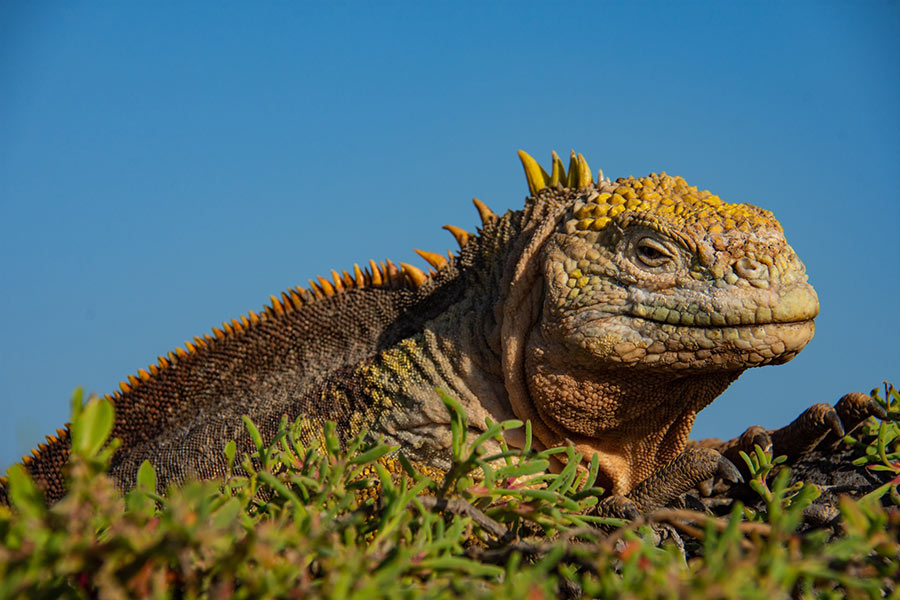
Galapagos land iguana basking in the sun at South Plaza Island
Although their mottled, leathery yellow skin with a crested back and thick claws can appear a little otherworldly, they always appear intrigued by visitors and lord over the islands. They fiercely defend their territory with a bob of their head, and will sometimes fight one another. The prickles of the prickly pear cacti are no match for their claws and tough skin which they need for survival, especially for hydration in the middle of summer. When they aren’t foraging for food, they hide in burrows or in the crevices between lava rocks to protect themselves from the beating sun.
Santa Fe Land Iguana: One of Galapagos’ Endemic Species
As the name implies, this endemic species can only be found on Santa Fe Island. It is notable for its smaller dorsal fins and has adapted to a slightly paler yellowish-brown coloring that allows it to blend in with its surroundings. While visiting Santa Fe Island, you may get the chance to see the intriguing symbiotic relationship between these magnificent iguanas and Darwin’s finches, which descend upon them to feed off the parasites found on their backs!
Only on Santa Fe Island!
Galapagos Hawk: The archipelago’s top predator
The Galapagos Islands also have their very own endemic hawk. It is easily spotted by its heavy build although its coloring can differ from sooty brown to black and white. Depending on the area in which it is found, it can vary significantly in size. These soaring predators are known to snack on iguana or turtle hatchlings, but will also feed on insects and carcasses. In every situation, the dominant hawk will always eat first while its lieutenants stand guard.
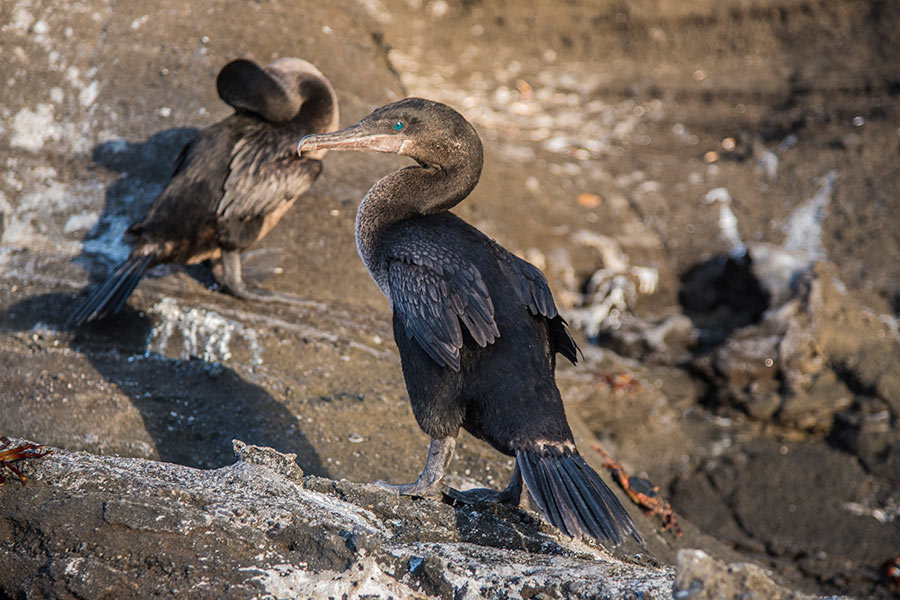
Flightless Cormorant in Fernandina Island, Galapagos
Many endemic Galapagos species have adapted effectively to their place on the islands, thanks to a relative lack of predators. The flightless cormorant is no exception as it is the only cormorant in the world known to be flightless. As it doesn’t need to travel far for food, it has chosen to become quite sedentary, most likely staying within a 660 ft2 (200 m2) area throughout its entire life. However, like its cousins, this cormorant also has webbed feet that it uses to propel itself through the water in search of food, such as fish, squid, and octopus.
The mating ritual of the flightless cormorant begins with an impromptu synchronized dance in the water, in which the two cormorants swim around each other before moving to land. The male will try to woo the female with gifts of seaweed and other flotsam that he can find along the shore. Should his advances be accepted, the pair will care for their eggs together. If food is abundant and the chicks are nearly 70 days old, the female will ditch her mate in search of another male to start another brood.
If you really want to see them, check out our Galapagos Cruise and Scuba Diving Adventure Package!
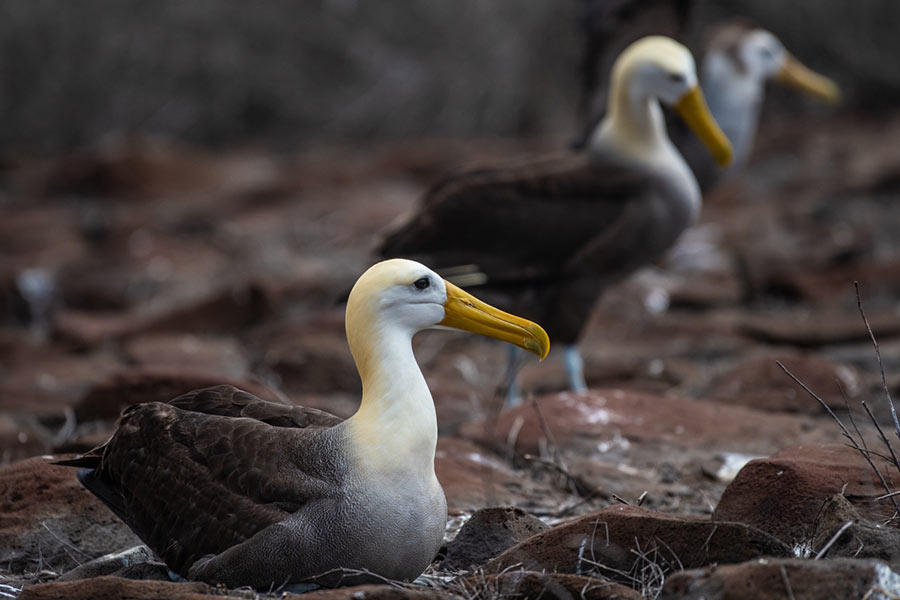
Galapagos Albatross in Española Island, Galapagos
This is the only albatross located in the tropics. Also known as the waved albatross due to the markings on its wings, it is easy to spot, with a bright yellow bill, yellowish cream-colored neck and head, and brownish body. The albatross’ feet tend to be light blue.
Interestingly enough, this fascinating species produces a special stomach oil, which is used as a defense mechanism against predators. Albatrosses feed on energy-rich food sources, which are particularly good for feeding chicks and preparing for long flights.
Don’t forget to check out our Galapagos Tour Packages or contact one of our helpful Destination Experts to find out the best way to see these 15 incredible Galapagos species!